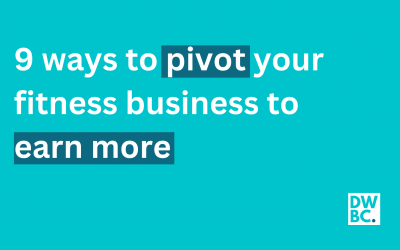For many fitness professionals starting a new business or venture, there’s a misconception that once they establish their business, success will either come rushing in or not at all. They set the stage, introduce their offerings, and then await the influx of clients. If the crowds aren’t queuing up, it’s tempting to think perhaps there’s no demand for their specific service.
However, the surge in a fitness business usually comes from the relentless drive and push by its founders. While there are a few instances where a fitness venture might spontaneously take off, it’s the exception rather than the rule.
When launching a fitness business, you shouldn’t underestimate the power of direct engagement. Merely setting up a gym or creating a unique training opportunity won’t guarantee a flood of clients. The most successful gym owners and personal trainers often highlight the importance of taking proactive steps, especially in the initial stages.
Why do many fitness professionals hesitate to proactively pursue potential clients? For some, the challenge lies in stepping out of their comfort zone. Approaching individuals, possibly facing rejection, or managing feedback can seem daunting. However, to truly establish yourself in the fitness world, an assertive approach to marketing and outreach is needed.
Another common misconception is the allure of rapid, vast growth. Starting with a small clientele can seem disheartening. However, it’s the steady, consistent growth that often leads to long-term success. Imagine starting with 10 dedicated clients. If you focus on a growth rate of 10% each few weeks, by year’s end, the clientele base expands significantly. It’s the compounding effect that can transform those initial small numbers into a thriving community.
Your approach will naturally evolve with growth. In the early days, personalised sessions, tailored advice, and individual consultations might be your go-to strategies. But as your client base expands, incorporating group classes, virtual sessions, or even branching out becomes feasible.
Consider the humble beginnings of many of the successful business owners I mentor. Their success didn’t happen overnight. It often involved personal sessions, local workshops, and even door-to-door promotions. Establishing a robust presence in the fitness space requires determination, adaptability, and an understanding that initial hands-on efforts pave the way for future expansion.
In the fitness industry, you should aim not only to attract clients but to ensure their utmost satisfaction. Imagine a boutique gym where every new member receives an ultra-individualised experience. The goal is to ensure that every individual feels their decision to join your establishment or session was invaluable. Constantly think about innovative ways to enhance their experience.
Why does this seem like a novel concept for many newcomers in the fitness world? There are several reasons.
Firstly, many fitness professionals, especially those with an academic background, focus heavily on the technical side – creating the best workouts, understanding anatomy, or mastering nutrition. This scientific approach often lacks the customer-centric aspect. Historically, the fitness realm had trainers and experts who were solely dedicated to their craft, without the need to manage the entire client experience. But in today’s competitive market, that’s no longer an option.
Another concern is scalability. Many believe that providing unparalleled attention to each client is unsustainable in the long run. And maybe it is. But at the early stages, with a limited client base, there’s absolutely no harm in going the extra mile. And surprisingly, as your client base grows, you’ll discover that maintaining high standards of service becomes a part of your brand’s culture.
A major reason fitness professionals might overlook this is their own experiences. They gauge their services based on the standards set by larger, more commercial fitness chains. Such big establishments cannot possibly provide a personalised touch to each member. But smaller ventures can and should. This personalised touch is an advantage that small establishments possess – offering unparalleled attention and service that larger competitors can’t.
Once you start pushing the boundaries of conventional client engagement, it’s empowering to realise how far you can go to ensure client satisfaction.
To quote a phrase from the tech world, aim for “insanely great” experiences. It’s not about just having an outstanding workout regimen but ensuring the entire journey of being a part of your fitness community is memorable. For larger, established businesses, the focus might primarily be the product. But for those starting, it’s about the holistic experience, even if the initial offerings are still being polished.
Focusing on “insanely great” during the initial stages isn’t just about growth; it’s foundational in refining the offerings based on genuine feedback. The best products or services evolve through iterations based on user feedback. Launching a perfect fitness program or class isn’t the goal; engaging clients, understanding their needs, and iterating is. It’s tempting to wait for the perfect program, but immediate feedback, especially in the fitness world, is invaluable. Early adopters provide insights that no amount of planning can offer.
Direct interaction with your initial clientele offers the richest feedback. As your business expands and you might rely on surveys or larger-scale feedback mechanisms, you’ll often reminisce about the early days when direct client interactions gave you profound insights.
There’s merit in considering a strategic approach when establishing a fitness brand or service: starting with a niche before expanding to a broader audience. Think of it as fine-tuning a specific workout before rolling it out to diverse groups.
Take another example from the tech world: Facebook. Initially, it catered exclusively to Harvard students. While this strategy limited its reach, it allowed the platform to cultivate a loyal base that felt the service was tailored for them. Once it had a stronghold within this community, expansion became more feasible. When starting a fitness initiative, it might be wise to focus on a specific group – perhaps a local community, a university, or a specific age group – before attempting to cater to everyone.
Often, businesses employ this focused strategy inadvertently. They might create a service or product for their own needs and those of their close acquaintances, only later realising the broader appeal. This unintentional niche targeting can work wonders, but being aware of it from the outset ensures that you don’t overlook potential early adopters or key demographics.
In the fitness realm, other budding trainers or local fitness startups can be your best early adopters. They are open to collaboration, experimentation, and partnerships. Additionally, their growth can coincide with your own, creating a symbiotic relationship that benefits both parties.
For fitness professionals launching a new service or product, a potential strategy is to hyper-focus on one client or user initially. Consider this client as your prototype; refine and adapt your offering based on their feedback until it aligns perfectly with their needs. This meticulous tailoring, more often than not, results in a service that appeals to a broader audience. By satisfying this initial client, you’ve essentially created a foundation that resonates with others. Even if the immediate audience is limited, adjacent demographics may discover value in what you offer. The key is to identify at least one individual who genuinely benefits from your service; this sets the trajectory for the growth and refinement of your venture.
Taking a consulting approach, especially when working with businesses, can be quite beneficial. For instance, if you’re a personal trainer specialising in corporate wellness, instead of merely offering generic plans, curate and customise plans based on a specific company’s needs. The direct engagement might seem non-scalable, much like consultancy, but it’s highly valuable in the initial stages. The pitfalls arise when this becomes transactional—when clients begin paying for every minor modification or attention to detail. However, if you remain a service provider who’s merely being exceptionally attentive to a client’s requirements, they’ll be appreciative, even if not all their desires are met.
Sometimes, a manual approach can be the stepping stone to automation. By handling processes personally in the early stages, you not only gain a deeper understanding of the intricacies but also identify areas that need automation.
Some fitness ventures might begin entirely manual. Imagine a diet planning service where every meal plan is hand-crafted based on individual consultations. The objective is to gradually pinpoint the commonalities and automate those, ensuring the service remains relevant and user-centric. It’s more rewarding to have a manual process that genuinely benefits users than an automated one that misses the mark.
Starting a new fitness venture comes with its own set of misconceptions. One widespread myth is the idea of the “Grand Opening” – the belief that a massive, simultaneous launch across various platforms ensures immediate success. While this may sound appealing, ask yourself this: How many grand openings of successful fitness centres or programs do you genuinely recall? The essence of a launch is to acquire a foundational client base. The success in subsequent months depends more on the satisfaction of these initial clients than on their sheer number.
So, why do some fitness entrepreneurs give monumental importance to launches? It often boils down to a mix of overconfidence and a desire for an easier route. They anticipate that the uniqueness of their service will draw in masses instantly. However, acquiring and retaining clients is usually a step-by-step process. This is primarily because clients need time to trust new ventures and adjust to novel offerings.
Similarly, banking solely on partnerships, especially with bigger brands, in hopes of rapid growth often ends in disappointment. Many budding fitness entrepreneurs believe that collaborating with a significant name in the industry will be their ticket to widespread recognition. However, most end up realising that these collaborations require immense effort with little to no immediate reward.
Success in the fitness industry isn’t merely about introducing an exceptional service. It requires an extraordinary initial effort. Any plan that sidelines this effort, hoping for a grand launch or a miraculous partnership, is inherently flawed.
Perhaps it’s beneficial to view new fitness ventures as dual-faceted. One facet concerns the offering, and the other concerns the initial efforts to establish and promote it. Looking at new ventures in this light allows creativity not just in the service or product but also in its promotion. But usually, the second facet boils down to the age-old formula: handpick your initial clientele and provide them an unparalleled experience.
Embracing this dual-faceted approach can ingrain invaluable habits into the very fabric of the business. Efforts made during the initial phases shape the long-term trajectory. If you start by personally reaching out to potential clients, this proactive attitude likely stays even when the client base expands. If you take feedback personally in the early days, this receptiveness becomes a company trait. Importantly, the drive to go above and beyond for every client, from the very first to the hundredth, ensures a consistent and high-quality service.





